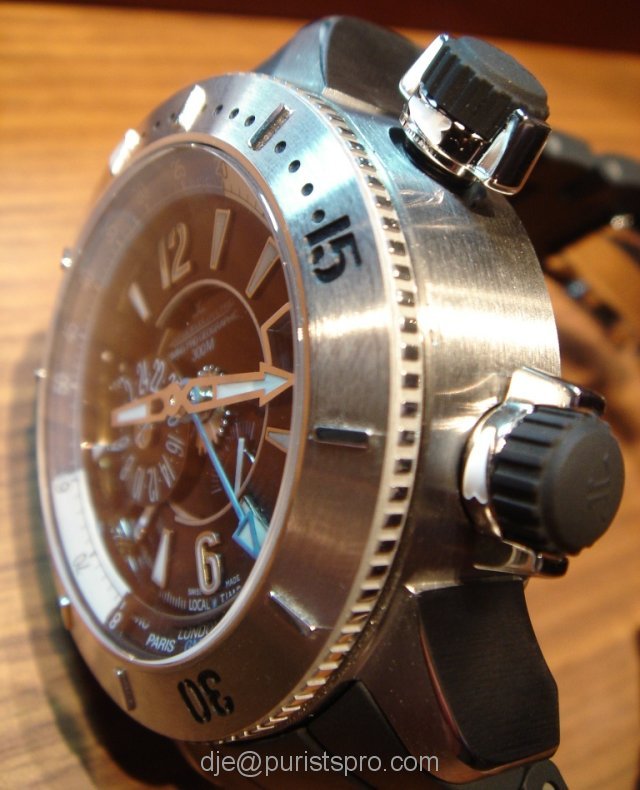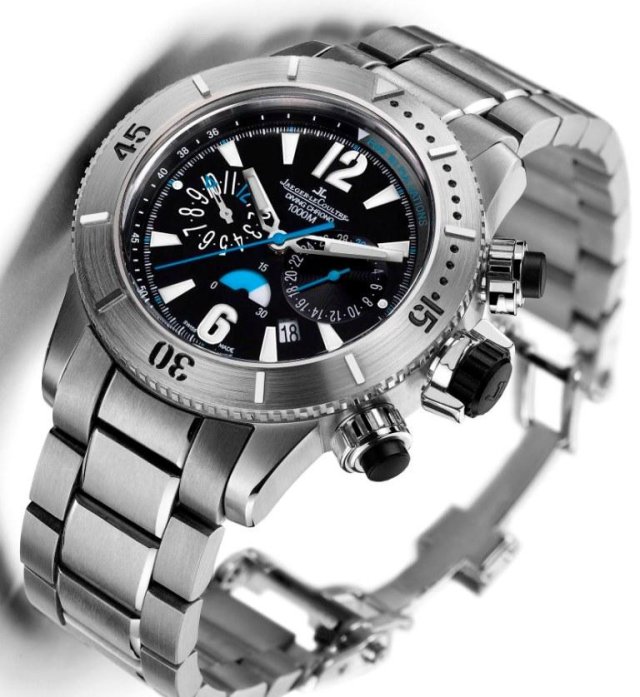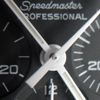
Dje
7712

SIHH 2007 report: the new range of Jaeger-LeCoultre men's diving watches ...
When SIHH 2007 is closing its doors in a few
hours, I'm happy to share with you the following report about what is a
new range of watches from Jaeger-LeCoultre.
All fall and winter long we've had
rumours about a new diving watch, neo-Polaris or not.
This is not a new diving watch, but a full
range of diving watches that comes to us now.
You've already seen many pictures
around so let's go into the details now.
What is Jaeger-LeCoultre? Although we
cherish our own classical Reverso and Master models, these watches are not
enough to define the brand spirit and mission.
Jaeger-LeCoultre intends to be the most
inventive company of the higher end horology. No less. In the last years
we've seen the Gyrotourbillon and its spherical tourbillon, the Master
Minute Repeater and its gongs fixed on the front crystal of the watch, the
Grande Complication a Triptyque and its new escapement, tri-dial configuration
with perpetual calendar, time equation…., the Amvox2 and its dial
operated chronograph, the new Extreme Lab, the new Duometre a Chronographe and
finally this range of diving watches (plus all those I forgot).
Let's be frank and clear. This new
range of diving watches is a range of tools (at least the men's models).
I know that some (I am among them) are waiting for new classical understated
models in the Master range. They won't come this year but we will get
them don't worry (I can't say more).

The star of the
diving collection is obviously the Master Compressor Diving Pro Geographic.
This is a 46.3mm watch with a mechanical depth gauge. The case is made in satin
brushed Grade 5 titanium and the watch is water-resistant to 300 metres. A limited
series of 200 pieces in platinum will be also available.
The movement is
the new automatic calibre 979,
a 48 hour power reserve hand crafted and decorated
derivative of the "autotractor" calibre 975.

This is a thick
tool watch with a 3.6mm thick cambered sapphire crystal and a more than 5mm
thick back at its thickest point. For 44mm models rated to a 1000 metres water
resistance the pressure on the crystal at 1000 metres depth is 890 kg!
This is
somewhat the first Atmos on the wrist, with a different purpose though. The
device used to indicate the depth is a membrane that expands or contracts
according to the aquatic pressure exercised on its metal head. It may remind
you of the gas capsule expansion depending on the variations of air
temperature, used in the Atmos to wind the mainspring.
In the Master
Compressor Diving Pro Geographic the depth indication is done through a rhodium
plated rack visible on the dial and connected to the membrane though a central
pinion. The depth indication works from O to minus 80 meters, the first 40 meters being more
detailed thanks to a logarithmic-scale calculated shape of the rack and pinion.

You can see the
working of the depth gauge on the left side of the watch case. You can push on
the black metallic head of the gauge to check that it works. Push smoothly and
you'll see the blue hand move on the dial.

The compression
keys have a slightly larger diameter than the former Compressor models. The
handling is improved with the use of rubber allowing a better grip underwater.
This watch is
intended to be a perfect complement and a security check to the now generalized
electronic devices used by serious divers to calculate their diving times,
decompression stages and other stuff necessitated in order to guarantee the
safer dive.

The window at
six on the dial indicates the place linked to the second time zone dial at
nine. You also get a date at three.

The luminescent
movement operating indicator is located right under the central hands axis. A
luminescent rectangle is there to prove while moving that the movement is
running.

The rotating diving
bezel has a 120 tooth system that allows a 30 seconds precision. A luminescent reference
triangle allows perfect readability of the bezel underwater.
The Diving Pro
Geographic is a large watch indeed but this range gets a new designed case with
reshaped lugs that make it fit smaller. The 44mm models are pretty wearable for
smaller wrists and in my opinion seem smaller on the wrist that 41.5 former
Compressor models. The case is though in the thick league, being designed to
resist to high underwater pressure (water resistant to 1000 metres for the
44mm models).

The blue colour
was chosen because it is the colour that ensures maximal contrast underwater. Between
30 and 60 meters
blue is supposed to be the only visible colour. The actual visibility of
colours underwater is a function of water composition, water acting as a filter
to the light.
Several options
of strap are offered. You can either get a titanium links bracelet or an
articulated triple-link bracelet composed of a metal frame molded in black
rubber. All watches get an additional diving-strap in Cordura with Velcro
fastening. The 44mm models (Diving Chronograph and Diving GMT) can also get a
rubber-clad strap.

The Master
Compressor Diving GMT is water resistant to 1000 metres. It shows
central local time that can be incremented by one hour jumps forward or backward.
There's a second time zone on a 24h subdial at 9. The date appears at 3.
The window at 6 is a luminescent operating indicator. Once again the blue
colour ensures the best readability underwater of this indicator.
This watch is
powered by calibre 975D and is available in a limited series of 1500 pieces in
titanium.

Another 44mm
option is this quite appealing 1000 metres water resistant chronograph. The
pushers are obviously fitted with compression keys. The luminescent movement
indicator is there at 6 through a rounded window.
The inner ring
of the dial shows a pulsometer that calculates the heartbeats per minute. You
stop the chronograph after 30 heartbeats and it shows the number of heartbeat
per minute. The calculation of heartbeats is essential to free divers. The aim
of a slow heartbeat is essential to improving the diver capacity to longer
dives.
The chronograph
will be available in pink gold or in a limited series of 1500 in titanium.
This range of men's
diving watches brings us a nice choice among three appealing pieces that
emphasize the technical inventiveness of Jaeger-LeCoultre.
These are real
diving watches and fill nicely the gap in the Jaeger-LeCoultre range.
Dje

SIHH 2007 report: the new range of Jaeger-LeCoultre men's diving watches ...


No there isn't

Is blue last colour visible and so what anyway?

The blue highlights on these watches are luminescent,

